While roller cone bit technology still continues to make advances in insert shape, carbide composition and hydraulics design.
Mark Tran, Engineering Editor
Roller cone and PDC bit design has progressed from its fundamental foundation laid nearly fifty years ago. Factors such as depth of cut, cone offset angle, cone geometry, journal angle, tooth/insert count and spacing are still a part of this foundation. Modern design, as shown by the new products presented in this article, focus on details such as bearing configuration, bottomhole coverage and inter-insert (teeth) clearance relative to adjacent cones. Modern design focuses on modeling cone tracking as a measure of bottomhole clearance. Bit designers rely not only on bit run simulations in a particular formation, some simulate the effect of the BHA on the particular bit to get a complete picture of forces affecting bit performance. As new bits are introduced, they are also accompanied by ancillary services such as custom designing each bit to a particular application. The following new designs show that this will be the continuing trend.
NEW TECHNOLOGY OVERVIEW
The following companies have released new technology within the past year.
United Diamond and Ulterra Drilling Technologies. The TorkBuster torsional impact generator from United Diamond and Ulterra Drilling Technologies enables PDC bits to drill tough formations by supplying impact energy. “When a PDC bit enters high-compressive strength formations, there is a possibility for stick-slip to occur. If insufficient torque is available to fail the formation, the drill string will wind up and store energy,” Rick Dudman, Downhole Tool Manager at Ulterra/United Diamond, explains. “Once the energy required to shear the formation is accumulated, the rock shears and triggers a violent release of stored energy that causes higher-than-normal impact loads on the PDC cutters. This will cause chipping and de-lamination of the diamond surface, eventually leading to a damaged bit and a shortened run.”
The impact generator applies a high-frequency torsional impact to the bit which, when combined with steady-state drillstring torque, results in an increase in horsepower directly at the bit. Run directly above a PDC, the impact generator is a short tool, Fig. 1. It has been run in directional wells below the motor in sliding mode and in vertical wells with high-performance motors.
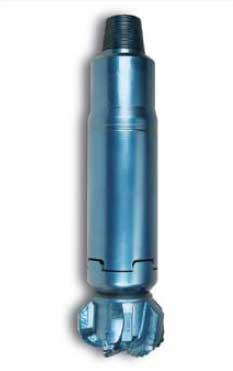 |
|
Fig. 1. The TorkBuster torsional impact generator from United Diamond and Ulterra Drilling Technologies.
|
|
Diamant Drilling Services. Diamant Drilling Services has developed a fixed cutter bit, which leaves the center of the hole uncut, Fig. 2. The lack of bit center leads to the creation of a core, Fig 3. This core is broken by the bit itself and ejected at the side through a slightly enlarged junk slot. The core is then carried to the surface along with the other cuttings. This process leads to high quality cuttings for surface examination. The improvement is especially important where normal cuttings quality is poor due to the use of turbines or high speed motors together with impregnated diamond bits.
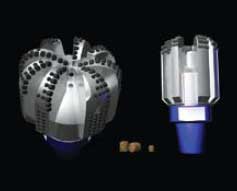 |
|
Fig. 2. Diamant Drilling Service’s 8-in. Diamond Impregnated MicroCore Bit (right) and a 16-in. PDC MicroDesign for Middle East Market.
|
|
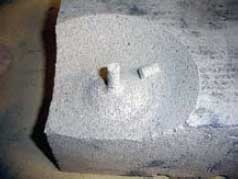 |
|
Fig. 3. Example of bottom-hole pattern generated by Diamant Drilling Service’s PDC MicroCore bit showing a generated MicroCore.
|
|
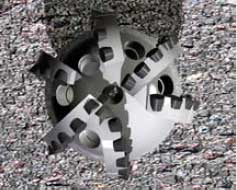 |
|
Fig. 4. Diamant Drilling Service’s 6-in. PDC MicroCore design.
|
|
The coring feature can be incorporated into impregnated diamond and PDC bits, Fig. 4.
Smith Bits. Smith Bits recently introduced the Shamal Typhoon (ST) product line of roller cone drillbits, developed specifically for the unique challenges of Middle East drilling applications. This product line was developed because vast regions of the Middle East are transitioning into mature drilling provinces. One such opportunity for improving economics is in the large, upper-hole sections drilled through relatively soft formations with technologies that deliver increased performance and decreased risk.
A study of the lithology/rock strength was undertaken to determine shale type/content and compressive strengths of formations drilled in a typical 17-1/2-in. and 16-in. section using Smith’s Drill Bit Optimization System (DBOS), followed by exhaustive dull grading of bits run in the target application. A systematic hydraulics analysis was also performed to provide conclusive insight into the specific factors that control ROP-performance gains in the target application. The results of this analysis provided the basis for the new bit designs.
Technology platform. The ST platform is based on the synergistic combination of 13 patented and six patent-pending technologies including innovative cutting structures, a new hydraulics system, innovative insert geometries and the latest carbide materials.
CFD analysis. The hydraulic system was developed using Computational Fluid Dynamics (CFD) analysis techniques to evaluate fluid flow, to optimized cuttings removal and ensure the cutting structure is always drilling virgin formation. Specifically, the CFD modeling analysis was carried out to maximize ROP by balancing hydraulic flow, minimizing cuttings residence time and minimizing cuttings recirculation. CFD modeling analysis also minimized erosion by optimizing and controlling fluid velocity.
Nozzle systems. As a result of the in-depth CFD and field analysis, Smith engineering developed ST’s unique six nozzle hydraulics systems consisting of three vectored extended outer nozzles and three dome jet inner nozzles to deliver the optimum hydraulic solution, Fig. 5. The main hydraulics system directs fluid flow to the leading edge of the cones for exceptional gauge row cleaning without contributing to cone shell erosion. The dome jets are pointed at the mid and inner cutting rows but are located far enough from the cone to avoid steel erosion/lost inserts common with the traditional center jet. The combined effect of these six precisely oriented flow patterns creates significant improvements in the path and velocity of the drilling fluid. The system provides an optimized solution for bit and/or bottom hole balling environments or any combination of the two.
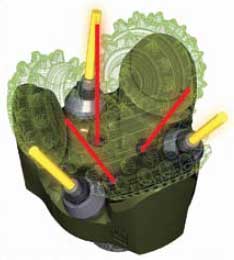 |
|
Fig. 5. The new roller cone technology from Smith Bits incorporates three vectored extended nozzles and three dome-jet inner nozzles to apply maximum hydraulic energy to the hole-bottom-enhancing cuttings removal, ultimately increasing penetration rates.
|
|
Cutting structure. Shamal Typhoon design engineers precisely calculated insert geometry and row positioning to achieve the ideal balance between maximizing ROP while retaining a high level of durability, Fig. 6. The new row geometry is complemented by an array of insert shapes that enable tailoring a bit’s cutting structure to ensure optimal ROP performance, Fig. 7. The Inciso is the latest insert shape and joins the Dogbone, ACE, and chisel inserts. Engineers can use a combination of insert geometries on a single design in order to fine-tune a bit to the operator’s application-specific requirements.
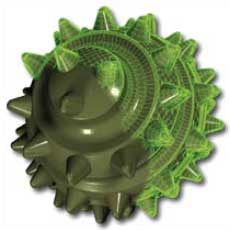 |
|
Fig. 6. The insert layout of each Smith ST bit is optimized for the target application.
|
|
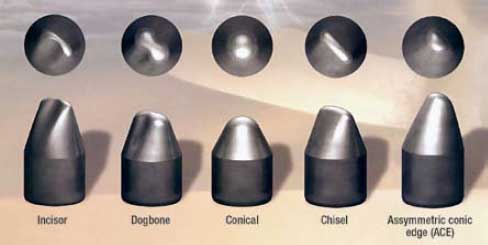 |
|
Fig. 7. A broad range of TCI inserts from Smith Bits are available so designs can maximize performance in a given application.
|
|
New carbide grades. Smith Bits is a broad range of proprietary carbide grades with unique microstructure characteristics that offer the difficult-to-achieve balance of impact durability and abrasion resistance. These systematic advances enable the ST bit’s new carbide grades to provide significant increases in fracture toughness compared to those used in the original Shamal product line.
IDEAS. As an integral part of the Shamal Typhoon design process, engineers modeled and certified the performance of the ST bit in Smith’s Integrated Dynamic Engineering Analysis System (IDEAS). IDEAS is a comprehensive time-based 4D modeling tool that accurately predicts a bit’s performance and behavior using finite element analysis, laboratory-derived drilling mechanics and physical input data that accurately characterizes the attributes of the total drilling system. The accuracy of the IDEAS system then allows the designer to certify the performance in a virtual environment so the operator is assured the bit will meet their performance objectives.
Halliburton Security DBS Drill Bits. With introduction of new Direction by Design software, Security DBS Drill Bits provides a tool that quantifies the effects of even slight design changes on the ability of a bit to drill a deviated well-before the bit is built.
In this front-end approach to design engineering, Security DBS applies accumulated knowledge through a proven bit design platform that provides the unique ability to “model, measure and optimize” a design before the bit is ever run. Instead of trial and error, customers benefit from “art to part” engineering, so that what is designed is what is run in the field.
‘Art to part’ vs. trial and error. Incorporating first-hand customer input into the bit design function, Security DBS Application Design Evaluation (ADE) service specialists work directly with the customer to define application-specific bit solutions that account for both how the bit will be steered and how it interacts with the formation to be drilled. For example, the recognized benefits of controlling torque by limiting cutter engagement long ago made depth of cut a standard consideration in PDC bit design. Today, however, front-end engineering enables Security DBS bit designers to determine precisely how much to limit depth of cut, why to limit it, and when to do so - while always taking into account the directional tendencies of the bit.
Further advancing design engineering for optimal directional performance, the new Direction by Design software determines the effects of bit geometry parameters on steerability and walk rate for a given bit according to the specific drilling system used. Where previous kinematics models represented bit motion by axial penetration rate, rotational speed and lateral penetration rate or side cutting, the design software meshes specific bit design features and formation characteristics in three dimensions, and simultaneously uses bit rotation, axial penetration, tilting motion, and formation properties to simulate the bit/formation interaction, Fig. 8.
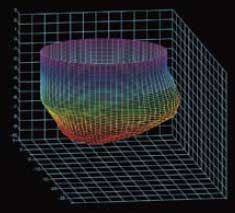 |
|
Fig. 8. A new cutter/rock interaction models both bit and rock in very finely meshed 3D spherical coordinate systems. Given bit kinematics in three drilling modes, interaction between cutter and formation can be obtained and forces on any element on bit can be calculated. Security DBS.
|
|
In terms of directional bit design, this enables designers to predict side force required, walk force and speed in azimuth direction for a specific bit design in a given drilling application. In addition, bit torque variance during directional drilling is calculated to account for different bit behaviors during kick-off, build and hold drilling modes. The new cutter/rock interaction model at the heart of the design software enables directional drill bits to be designed with optimum bit walk characteristics for drilling a specific wellbore profile with a specific drilling system. As a result, PDC bit designs can be optimized and sent to the field with directional performance attributes already known before the bit is ever run in hole.
Bit-Tech SPH. The B45T is Bit-Tech SPH’s new drillbit series, Figs. 9 and 10. Scott Strange, Bit-Tech SPH president, says the new series has an additional patent-pending, back-to-back, 13-mm and 11-mm tandem-cutter arrangement that will be available in variable configurations custom made for each application, Fig. 11. Also, available will be the new patent-pending variable-groove depth PDC cutters in a flat and dome configuration with a host of other patent pending cutter options, Fig. 12. The B45T is an upgrade from the company’s B45 Series five-blade PDC bit. The B45T is in the early testing stages in Canada and will be available in early 2009 in the US.
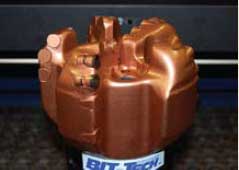 |
|
Fig. 9. Bit-Tech’s new B45T designed with its back-to-back tandem cutter arrangement.
|
|
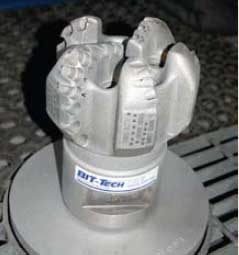 |
|
Fig. 10. Bit-Tech’s B45T, shown without cutters.
|
|
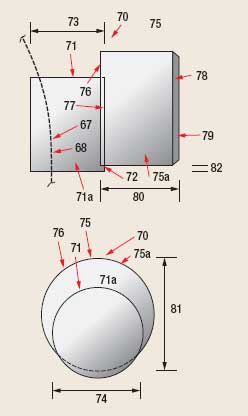 |
|
Fig. 11. Schematic drawing Bit-Tech’s back-to-back 13-mm and 11-mm tandem cutter arrangement.
|
|
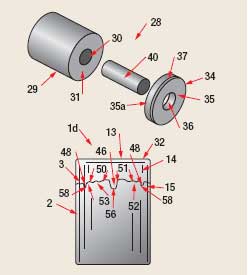 |
|
Fig. 12. Schematic drawing of Bit-Tech’s patent-pending variable groove depth PDC cutters in a flat and dome configuration with a host of other patent pending cutter options.
|
|
NOV ReedHycalog. The primary challenge for most operators with directional drilling systems is the control of vibration that can be very detrimental to overall performance and drilling efficiency. The SystemMatched Directional Solutions product line from NOV ReedHycalog incorporates features to improve directional drilling performance. Within the proven Rotary Steerable line, SmoothTorque Torque-Control Components (TCC) can be located in the face of the bit to reduce stick-slip problems, Fig. 13. The SmoothSteer tapered gauge can be used to facilitate bit tilt, reducing torque problems and improving dogleg capability. The range also includes a selection of gauge geometries and cutting structures to provide the desired sidecutting to truly match the directional system and trajectory requirements.
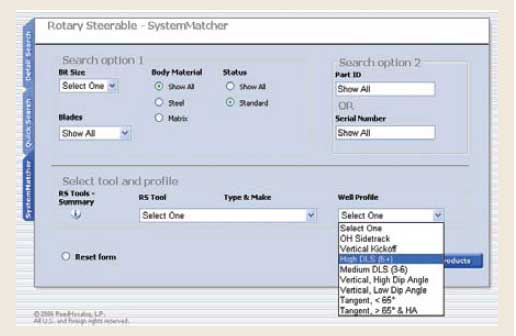 |
|
Fig. 13. NOV ReedHycalog’s SystemMatcher software incorporates logic regarding tool operation and trajectory requirement, and assesses these against key characteristics of the bit including length, profile, gauge geometry, cutting structure and sidecutting capability.
|
|
The fixed-cutter motor-steerable bits have been engineered to suit the more powerful steerable motors now in common use. These bits deliver superior tool-face control while maintaining high ROP in both sliding and rotating modes. The motor steerable bits have four fundamental design features that include use of the SmoothTorque TCC, but also specific SmoothTorque lateral inserts and a unique gauge design that efficiently reams the hole and reduces drag. Within the SystemMatched product line, the offset of the TCC inserts is critical to torque control and can be readily modified, allowing the cutting structure to be optimized for penetration rate, rather than limiting the ROP to control torque. This is an advantage over design concepts that fix the offset at the manufacturing stage.
To ensure consistent and accurate matching of the bit to the specific drive and trajectory, NOV ReedHycalog developed an interactive, intranet tool for optimization of bit selection. This unique SystemMatcher software incorporates logic regarding tool operation and trajectory requirement, and assesses these against key characteristics of the bit including length, profile, gauge geometry, cutting structure and sidecutting capability, Fig. 13.
Hughes Christensen. For holes 16 in. and larger, Hughes Christensen’s Big Quantec PDC bits contain advances in PDC cutter technology and bit stability to drill further and faster consistently. PDC drilling in large-diameter holes is challenged by high torque and excessive vibration. This new PDC addresses these challenges with strategically engineered technology, Fig. 14.
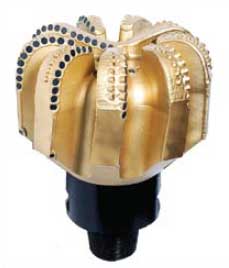 |
|
Fig. 14. Hughes Christensen’s Big Quantec PDC bit.
|
|
Diamond Volume Management optimizes the profile and cutter position for minimal vibration. Patented EZSteer depth-of-cut control technology offers excellent directional control, reducing bit reactive torque to manageable levels. Patented Lateral Movement Mitigator delivers secondary stability. Computational fluid dynamics optimizes hydraulic performance. The new bits are equipped with application-specific cutters, appropriate for the formation.
GaugeProXPR expandable reamer is Hughes Christensen’s newest concentric hole enlargement technology, Fig. 15. A ball-drop mechanism activates the cutter blades, which are deployed with fluid circulation and deactivated when circulation is stopped. This design eliminates premature triggering independent of WOB, flow or BHA pressure, with the pilot bit design synchronized to the expandable reamer in a fit-for-purpose drilling assembly. Operators can drill and ream simultaneously or enlarge a previously drilled pilot hole. The blade motion-angled radially outward and upward-is a fail-safe measure to ensure cutter blade retraction.
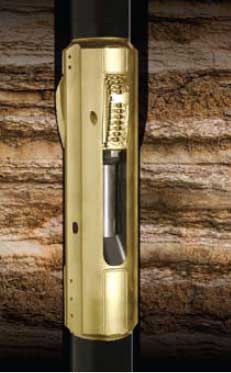 |
|
Fig. 15. ghes Christensen’s Gauge Pro expandable reamer.
|
|
The new expandable reamer uses a simple design with minimal parts and no complex tool mechanisms. The one-piece body is constructed from a high tensile, fatigue-resistant material. This design, combined with proprietary hardfaced interchangeable wear pads, is designed to mitigate heat-affected zones and crack propagation. Interchangeable nozzles for each cutter blade are placed strategically, through computational fluid dynamics analysis, improving cuttings removal and transport.
Varel International. Operators continue to demand increased energy inputs on drillbits through greater WOB and higher RPMs for faster drilling. This energy causes additional stress to the internal components of the drillbit and can cause issues downhole. Drillbit technology has evolved to meet the industry demand by offering solutions to thermal degradation of drillbit components and more effective cleaning of the wellbore for greater efficiency.
Varel International developed the High Energy roller cone series to address and meet these industry requirements, Fig 16. The company used a systematic approach and produced a series that can reliably withstand high energy inputs while maintaining drillers’ expectations of high ROP and increased footage.
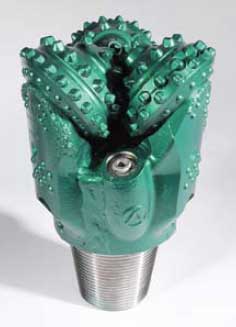 |
|
Fig. 16. Varel’s High Energy series roller cone bit.
|
|
Seal enhancements in this new series led engineers to two patent-pending innovations; the seal gland geometry and a thermal heat shield. The Varel team developed a conical seal gland which positions the seal in such a way that it can better handle pressure fluctuations and still maintain a preferred sealing location and interface. The addition of a heat shield disc deployed between the seal and the inner bearing acts as a thermal insulator, protecting the seal from excessive thermal energy.
The improved seal/bearing system incorporates a more robust journal bearing in order to support heavier loads. This was accomplished by reducing bearing clearance variations and restructuring the bearing areas. An additional modification is the advanced lubrication compensation system, featuring a self-draining reservoir chamber to reduce cuttings build-up adjacent to the top of the reservoir, protecting components from damaging debris. These enhancements work together to improve the longevity of the seal/bearing system and extend the life of the drill bit.
Precision hydraulics and cleaning efficiencies. The V-jet enhanced hydraulics package is included in the series to provide improved hydraulic and cleaning efficiencies. The package provides precision aiming of the nozzle flow to achieve excellent cuttings cleaning of the teeth while also avoiding erosion of the bit’s cones and the borehole wall due to recirculation.
Bridgeable technology. Varel has created a closed-loop system, specific to drilling applications, for drillbit design and optimization. By exploiting the synergies of their multiple software platforms, software engineers bridged separate pieces into a more holistic system. Instead of stand-alone products, the company has developed a process for drillbit optimization: the output of one software tool is the direct input to another simulator.
GeoScience, Varel’s proprietary well log, lithology and rock property analysis software, uses customer-supplied mud logs, drilling logs and electric log data to build a virtual model of the well sections to be drilled. During this process, offset bit performance is evaluated using a specific energy method and a proprietary criterion named Drilling Impedance (DRIMP) that allows for correlation across different bore diameters. The method allows the program to more accurately define the cutting structure, type and size of PDC cutter to be recommended for the application through its output.
Using the GeoScience outputs as a guide, the drillbit design and custom cutting structure is then created with the SPOT (Simulateur Pour l’Optimisation des Trépans) software package. This engineering tool can predict a PDC bit’s directional behavior and cutting structure efficiency and match that with the operations needs in term of bits directional signature as well as provide a performance prediction for the lifespan of the bit. Based on the combination of these two software packages, a complete simulated well is possible. The design is modeled and the cutting structure is analyzed in the defined application and environment and with the particular drive that will be used.
After reviewing the results, an optimized cutting structure is modeled and run again in the numerical drilling simulator to verify that the modification is addressing the required necessary optimizations noticed in the first cutting structure iteration. The bit signature is defined and parameters guiding the manufacturing of the bit are delivered. 
|


















